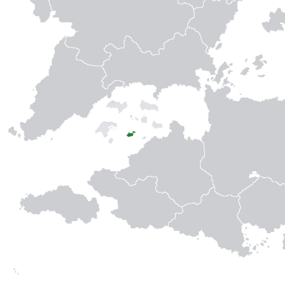User:Planita13/Kingdom
Kingdom of Carucere Kigdo Karuke (Carucerean Creole) | |
|---|---|
| Motto: "Pou Wa ak peyi" (Carucerean Creole) ("For King and Country") | |
| Anthem: "Karuke Cheri Peji" ("Carucere Beloved Country") | |
 Location of Carucere (green), within the Golden Isles (light grey) | |
 | |
| Capital and largest city | |
| Official languages | Estmerish |
| Recognised national languages | Carucerean Creole |
| Ethnic groups (2021) | |
| Religion (2021) |
|
| Demonym(s) | Carucerean Karukais |
| Government | Federal parliamentary constitutional monarchy |
• Monarch | Henri Endrijauskas |
• Premier | David Jonas |
| Legislature | Senate |
| Independence from the Gaullican Empire | |
• Carucerean Revolt | 28 June 1750 |
• Coronation of the Monarchy | 4 May 1764 |
• Recognized | 14 February 1771 |
• Current Constitution | 12 August 1952 |
• Joined the ACO | 1988 |
| Area | |
• Total | 8,121.52 km2 (3,135.74 sq mi) |
| Population | |
• 2021 census | 607,238 |
• Density | 74.7/km2 (193.5/sq mi) |
| GDP (PPP) | 2021 estimate |
• Total | $10.8 billion |
• Per capita | $17,937 |
| GDP (nominal) | 2020 estimate |
• Total | $6.4 billion |
• Per capita | $10,607 |
| Gini (2021) | medium |
| HDI (2021) | high |
| Currency | Arucian shilling (ARS) |
| Date format | dd/mm/yyyy |
| Driving side | right |
| ISO 3166 code | CAR |
| Internet TLD | .cr |
Carucere (Carucerean Creole: Karuke, IPA: [kaʁuke]), formally known as the Kingdom of Carucere (Carucerean Creole: Kigdo Karuke), is a small island nation between Asteria Superior and Asteria Inferior in the Arucian. It is geographically situated as part of the Golden Isles archipelago in the Western Arucian Sea. Consisting of the main islands of Marien and Magua, and numerous much smaller islands, it shares maritime borders with Sainte-Chloé to the west, Imagua and the Assimas to the north, and Aucuria to the east and south.
Before the arrival of Euclean settlers, the islands were home to a confederation of Nati tribes who traded with their neighbors. Carucere was discovered by Euclean explorers during the voyage of the Gaullican explorer Auguste de Antibes, who initially named it after the Queen of Gaullica, Anne the Financier. The Estmerish destroyed the confederation and established the Colony of Karukera in 1533, founding Jameston next to the strait between Marien and Magua, which formed a large natural harbor. Tens of thousands of Bahian slaves were transported to the islands to work on plantations. The island's strategic location and ideal geography for a naval base played a critical role in Estmere's attempts to contest Gaullica's control over Arucian Sea. Following Estmere's defeat in the Ten Years' War in 1721, the colony was annexed by Gaullica and renamed Saint-Brendan. Gaullican control remained until a major revolt by the Maroons broke out in 1760 who seized most of the interior of Marien. In 1763, the illegitimate son from a Ruttish noble house named Teodoras Endrijauskas was crowned as King of Carucere in exchange for his support. Due to his efforts and the Asterian War of Secession, Carucere gained de facto independence at the end of the war although its status as an independence state would not be solved until 1780.
Carucere remained a largely underdeveloped and agricultural country, although the capital city of Jameston experienced some development as a port of call. During the Great War, the island was invaded and occupied by Gaullica. After the Great War in 1935, the islands were transferred to a joint Allied commission which later established the Arucian Federation which consisted of former Gaullican colonial possessions, including Sainte-Chloé. Under the Federation, it experienced a political, economic, and social revolution as part of the wider Arucian Naissance. In 1945, both states formed an independent federation with Bonaventura and Imagua and the Assimas, forming the United Provinces of the Golden Isles. Under the United Provinces, the islands were ruled by the former colonial elite which bred resentment and further social change. The collapse of the United Provinces led to Carucere’s independence in 1954 and the restoration of the monarchy. The new republic was characterized by political instability until Premier Jean Preval arose to power in in 1970. His government saw wide ranging political and economic reforms that saw Carucere grow into a pluralistic and inclusive state; overseeing the promotion of multiracialism, the establishment of a common identity, and the development and diversification of the economy from a purely extractive and agriculture based one. Preval remained in office until his resignation in 1982.
Today Carucere is the only monarchy in the Asterias. It is an upper-middle income country with a rapidly growing and diversifying economy. The legacy of colonial rule is reflected in the country's extremely diverse ethnic and religious makeup. Carucere continues to experience occasional tensions between various ethnic groups especially between the predominant religion, Solarian Catholicism, and the various minority faiths of the country. The islands’ rapidly growing economy consists of a mix of agriculture, manufacturing, and various service-based businesses. However the disparities between different ethnic groups are very visible especially in income inequality and standards of living. Carucere is a member of the Community of Nations, the Organization of Asterian Nations, and the Arucian Cooperation Organization.

